


| [ Previous ] [ Next ] |

|
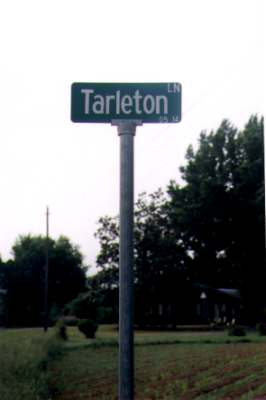
| On a country road along our route from King's Mountain to Brattonsville, I caught sight of this marker as it flashed by and commented, "I can't possibly have seen what I think I just saw..." Holley promptly turned the car around and, nope, I was not hallucinating. There really is a "Tarleton Lane" in rural South Carolina! Of course, it is almost certainly not named after Banastre. There were Tarletons living in the Carolinas before the war, and most or all of them were rebels. But it provided a good laugh and a Kodak moment. |
Brattonsville is a small historical park, with a beautiful plantation house and a number of other original or reconstructed buildings. Almost none of it dates back as far as the Revolution, but it's an interesting place to spend a couple of hours and worth a little out-of-period indulgence. It has a couple of second-hand Tarleton associations as an excuse. In 1780, a detachment of the British Legion went down in bloody defeat nearby, and Brattonsville was one of the filming locations used in The Patriot. (They've made up special fliers and exhibits to celebrate that fact.)
| These are two of the restored buildings on the site, both dating from the early 19th century. The one in the distance is the Brattonsville store (built c. 1800), and the closer one is called "The Bricks." The Bricks was built around 1840, originally used as a girls' school then later converted to a family home. |

|
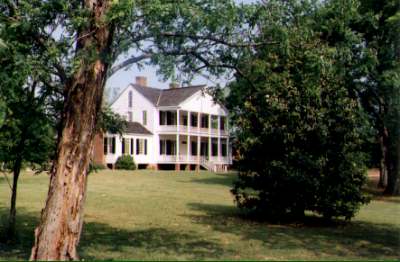
| The main house on the plantation, built by William Bratton's son early in the 19th century, is called "the Homestead." The interior is set up as a museum, with period furniture and accessories. (And currently, a large display on filming The Patriot.) |
| Another shot of the Homestead. Not our period, but a gorgeous building. |
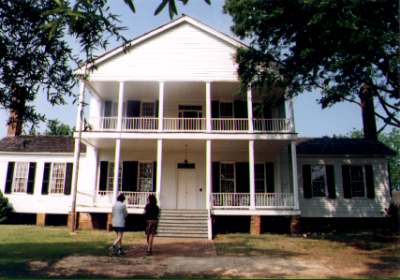
|
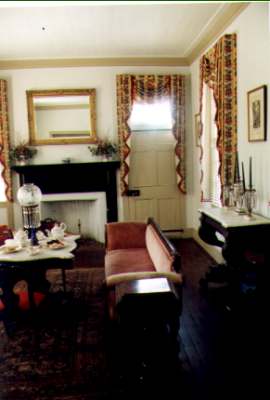
| The Brattons were wealthy enough to afford a formal parlor, which was still considered something of a luxury when the house was built. |
| Next to the parlor is a pretty, cozy sitting room. |
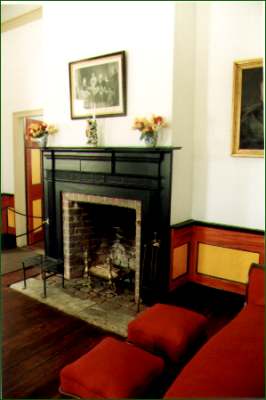
|
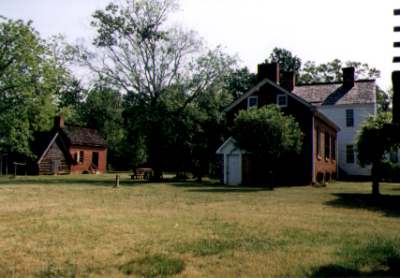
| Spread around the main house is the village of auxiliary buildings -- barns, storage buildings, spinning house, still house, work shops, employees' cabins, slave quarters, etc. -- required by a functioning plantation. The white building is the Homestead, seen from the back. The brick structure that extends back from it is the formal dining room/assembly room, which is a separate building connected to the Homestead through an open porch. (Interior shot follows.) |
| This formal dining room is in a separate extension built out the back of the main house. It was also used as a ball room. It should looking passingly familiar to anyone who has seen The Patriot -- it's the room where Tavington almost caught up with one of Ben Martin's kids. |
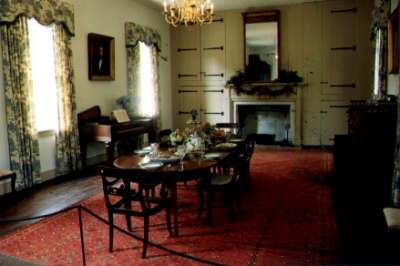
|
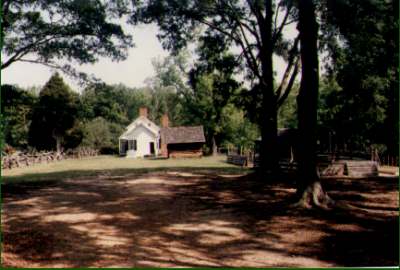
|
The white house shown here is the William Bratton house, which dates back
to 1776 (though it was extensively remodelled in the 1830s from its original
form). William Bratton was active during the Revolution as an officer in the
local militia.
When the main house was constructed, this older building was turned into a school. In the forested area to the right they have set up a simple home of the period -- the sort of home a normal farmer might own -- which was moved from another location. There is also a mock-up of the sort of primitive, one-room cabin settlers would have established when first moving into the area. |
One of the main reasons we stopped at Brattonsville is because it is near the site of the Battle of Williamson's Plantation (also known as the Battle of Huck's Defeat) where loyalist Captain Christian Huck was attacked and killed in July, 1780.
A path through the woods behind the William Bratton house leads to the field where the battle took place, which is indicated by another of the ubiquitous plaques. Huck was captain of one of the semi-independent companies that were amalgamated into the British Legion, and like Banastre Tarleton and James Wemyss, he has suffered badly from having his story told only by his enemies.
There are a half-dozen variations on the "eye witness" details of the battle itself, but the general gist of it seems to be that Huck's company was surrounded and attacked while they were asleep, in a pre-dawn raid not dissimilar to Paoli. Huck himself received a wound in the throat while trying to rally his command, and died on the field. There is much confusion about the battle, but as few as twenty of his 100-150 men may have escaped the slaughter, while only one member of the attacking force was killed. Those statistics are every bit as bad as Waxhaws, and reports on this battle are equally haunted by tales of the slaughter of prisoners -- yet predictably this battle is touted as a "seminal victory" not a "massacre" because the victors wrote the guide books. When word of the loss of Huck and his company reached Charleston, it prompted Ban Tarleton to an enthusiastic protest to Lord Cornwallis about his men being dispatched in isolated units that left them vulnerable to attack.
With appropriate irony we headed onward from Brattonsville to have a look at Waxhaws.
| [ Index ] | [ Previous ] [ Next ] |
| Return to the Main Page | Last updated by the Webmaster on January 30, 2004 |